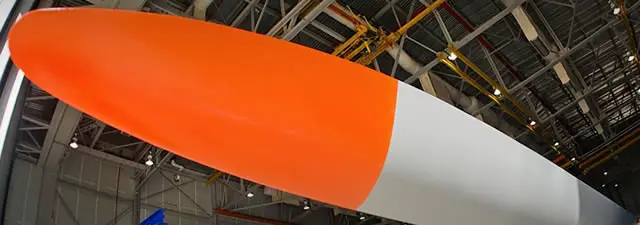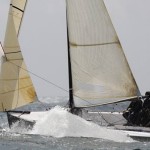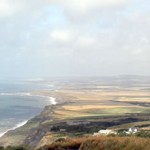Cowes-based Blade Dynamics have gained a £15.5 million investment from the Energy Technologies Institute (ETI) and plan to create jobs on the Island as a result.
On The Wight chatted to David Cripps, Senior Technical Manager, from the company today and he told us they have a new approach to creating large-scale wind turbines blades.
This will help them construct considerably longer blades than are currently possible, allowing them to increase in size up to 100m – 20% longer than the longest blades world-leader Vestas is currently developing. It’s anticipated that these longer blades, to be used off-shore, would generate between 8-10MW each.
Manufactured in sections
Their approach is to manufacture the carbon-fibre blades in sections, not in a single length as current blades are, and join the sections to form the blade. As David Cripps explained, “You don’t manufacture an aircraft chassis in a single piece, do you?”
The carbon-fibre brings the advantages of being lighter, as well as enabling them to make the blade thinner.
Other Island-based firms could benefit too
In another twist from the Vestas model, the manufacturing of the sections is done by sub-contractors, so other Island composite experts like Gurit, GKN and BAe could build the sections, ready for Blade Dynamics to construct. Vestas do the whole process themselves.
The tooling for the long blades is extremely expensive, when compared with manufacturing sections of between 12-20m, so it opens the market up for other suppliers to get involved.
The engineering brains of the operation will be on the Isle of Wight, made up of the technical design work, both of the blades and importantly the interconnection of the blade sections and the process development.
Assembled off-Island
Dynamic Blades anticipate the assembly of the blade will take place in Southampton or Portsmouth, primarily because there aren’t any waterside sites available on the Island where they could construct 100m items, important in order to ship directly.
David said the Blade Dynamics approach enabled them either to construct the whole turbine blade, or do it in two sections, with the final stage being executed at the site they would be used at.
Dynamic Blades also have a manufacturing base in the USA, at the NASA Michoud Assembly Facility in New Orleans.
Next generation of blades
To test the production methods, the initial blade will be scaled down to 80m, enabling the built blade to be fitted to current wind turbine towers for testing.
When asked if the 100m blades would be used at the proposed Navitus Bay, David Cripps said that they wouldn’t, as the blades of this length will be for the next generation of off-shore wind turbines.
Below is the press release that Blade Dynamics published today.
ETI invests £15.5 million in new turbine blade design with Blade Dynamics to enable the building of the world’s largest wind turbine blades
The Energy Technologies Institute (ETI) has appointed Blade Dynamics to develop and demonstrate the technologies for constructing what are expected to be the world’s longest wind turbine blades ever built.
As part of the £15.5 million project the ETI will become an equity investor in the Isle of Wight-based blade developer – helping with technology development and allowing the company to grow its workforce by up to a third in the short to medium term.
This is the second time in 12 months that the ETI has undertaken a private equity investment in a UK SME developing innovative new technologies.
Blade Dynamics will construct blades for the ETI of between 80 to 100 metres in length, incorporating carbon fibre rather than conventional fibre glass. This compares with blades now deployed offshore of between 60 to 75 metres in length.
The ETI commissioned and funded project will be delivered using Blade Dynamics’ innovative design and manufacturing processes that construct blades through the assembly of smaller, more accurate and easily manufactured component pieces, rather than from extremely large and expensive full-length mouldings.
The project will see prototype blades manufactured, and in a position to be put into production by late 2014. Structural testing for the first blade is then expected to be carried out at a UK test facility. The design of the blades will see them weigh up to 40 per cent less than conventional glass-fibre blades, enabling significant weight and cost savings to be achieved throughout the rest of the turbine system. The design will also help to reduce the cost of the energy produced.
The intended end use for the blade technology is on the next generation of large offshore wind turbines currently under development with a capacity of 8 to10MW. This compares with the 5-6MW capacity turbines currently deployed offshore.
The first stage of the project will focus on blade design in collaboration with a major turbine manufacturer (OEM). The project will also test detailed design and manufacturing technologies, extending Blade Dynamics’ current experience from manufacturing 49 metre blades. The second stage will establish and demonstrate the proposed manufacturing processes on blades designed for a current 6MW turbine. A design will also be developed for blades for future 8 to10MW turbines. Final project stages are intended to test and verify the prototype blade performance against the predicted performance.
Minister for Universities and Science David Willetts, Department for Business, Innovation and Skills, said: “This investment will enable Blade Dynamics to develop and demonstrate a potentially world-leading technology. The project could vastly improve the manufacturing process of very large turbine blades, as well as helping to reduce the cost of the energy generated. It shows Britain is leading the way in developing innovative solutions to help with the transition to a low carbon economy.”
Paul Trinick, Offshore Wind Project Manager at the ETI said: “Offshore wind has the potential to be a much larger contributor to the UK energy system if today’s costs can be significantly reduced. Investing in this project to develop larger, more efficient blades is a key step for the whole industry in paving the way for more efficient turbines, which will in turn help bring the costs of generating electricity down.
“Along with improved system reliability, the impact of larger blades is a crucial factor in helping to bring down the costs of generating electricity offshore. Our investment strategy here is to provide financial support to allow the company to develop its technology further, to accelerate and expand the testing of this UK technology, and to identify the large-scale development opportunity of this design approach.”
David Cripps, Senior Technical Manager, from Blade Dynamics added: “We have worked hard on the design of this blade technology for a number of years now. Financial backing from the ETI for this project allows deployment on ultra-large turbines far sooner than would otherwise have been possible and as a result of this project we will be hiring new engineers and technologists to make this possible. Our driver is to make the generation of electricity through offshore wind both more reliable and more economical. We believe longer, low weight blades to be a key part of the solution, but for such blades to be most effective we need to design their construction differently.”
–
Energy Technologies Institute (ETI) is a public-private partnership between global industries – BP, Caterpillar, EDF, E.ON, Rolls-Royce and Shell – and the UK Government.





